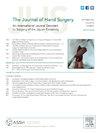触发手指释放后患者感知的恢复结果。
IF 2.1
2区 医学
Q2 ORTHOPEDICS
引用次数: 0
摘要
目的:扳机指松解术(TFR)是最常用的手部手术之一;然而,直到病人主观感觉恢复的时间没有很好的记录。关于任何类型手术后患者对恢复的看法的有限文献描述了患者和外科医生可能对完全恢复的时间有不同的看法。我们的主要研究问题是确定患者在TFR后主观感觉完全恢复需要多长时间。方法:在这项前瞻性研究中,接受孤立性TFR的患者在手术前和术后多个时间点完成问卷调查,直到他们报告完全康复。患者完成视觉模拟量表(VAS)疼痛评分和QuickDASH(手臂、肩膀和手的残疾),并询问他们在4周、6周、3、6、9和12个月时是否感觉完全恢复。结果:自报告完全恢复的平均时间为6.2个月(SD 2.6),自报告完全恢复的中位时间为6个月(IQR 4个月)。12个月时,50名患者中有4名(8%)感觉没有完全康复。从术前评估到最终随访,QuickDASH和VAS疼痛评分均有显著改善。手术后6周和3个月,所有患者报告的VAS疼痛评分和QuickDASH评分的改善大于最小的临床重要差异。术前VAS和QuickDASH评分较高与术后12个月未能完全恢复相关。结论:孤立性TFR术后患者感觉完全恢复的时间比资深作者预期的要长。这表明患者和外科医生在讨论恢复时可能考虑明显不同的参数。外科医生在讨论术后恢复时应该注意到这种差异。研究类型/证据水平:预后II。本文章由计算机程序翻译,如有差异,请以英文原文为准。
Patient-Perceived Outcomes of Recovery After Trigger Digit Release
Purpose
Trigger finger release (TFR) is one of the most commonly performed hand surgeries; nevertheless, the time until patients subjectively feel recovered has not been well documented. The limited literature on patient perceptions of recovery after any type of surgery has described that patients and surgeons may have differing views on the time until full recovery. Our primary study question was to determine how long it takes for patients to subjectively feel fully recovered after TFR.
Methods
In this prospective study, patients who underwent isolated TFR completed questionnaires before surgery and at multiple time points following surgery until they reported full recovery. Patients completed visual analog scale (VAS) pain scores and QuickDASH (Disabilities of the Arm, Shoulder, and Hand) and were asked if they felt fully recovered at 4 weeks, 6 weeks, and 3, 6, 9, and 12 months.
Results
The average time to self-reported full recovery was 6.2 months (SD 2.6), and the median time to self-reported full recovery was 6 months (IQR 4 months). At 12 months, four out of 50 patients (8%) did not feel fully recovered. QuickDASH and VAS pain scores improved significantly from preoperative assessment to final follow-up. All patients reported improvement in both VAS pain scores and QuickDASH scores greater than the minimal clinically important difference between 6 weeks and 3 months after surgery. Higher preoperative VAS and QuickDASH scores were associated with failure to fully recover by 12 months after surgery.
Conclusions
The length of time after surgery until patients felt fully recovered after isolated TFR is longer than the senior authors’ expectations. This suggests that patients and surgeons may consider distinctly different parameters when discussing recovery. Surgeons should be aware of this discrepancy when discussing recovery after surgery.
Type of study/level of evidence
Prognostic II.
求助全文
通过发布文献求助,成功后即可免费获取论文全文。
去求助
来源期刊
CiteScore
3.20
自引率
10.50%
发文量
402
审稿时长
12 weeks
期刊介绍:
The Journal of Hand Surgery publishes original, peer-reviewed articles related to the pathophysiology, diagnosis, and treatment of diseases and conditions of the upper extremity; these include both clinical and basic science studies, along with case reports. Special features include Review Articles (including Current Concepts and The Hand Surgery Landscape), Reviews of Books and Media, and Letters to the Editor.

 求助内容:
求助内容: 应助结果提醒方式:
应助结果提醒方式:


